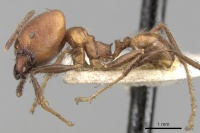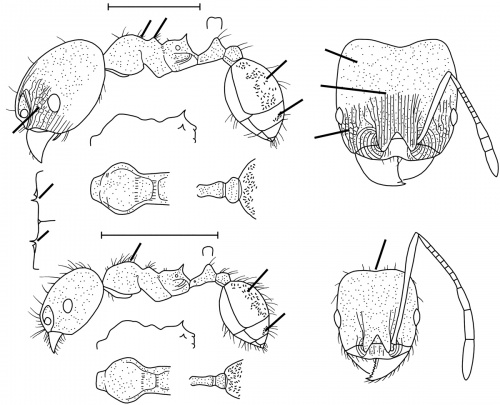Pheidole pugnax
| Pheidole pugnax | |
|---|---|

| |
| Scientific classification | |
| Kingdom: | Animalia |
| Phylum: | Arthropoda |
| Class: | Insecta |
| Order: | Hymenoptera |
| Family: | Formicidae |
| Subfamily: | Myrmicinae |
| Tribe: | Attini |
| Genus: | Pheidole |
| Species: | P. pugnax |
| Binomial name | |
| Pheidole pugnax Dalla Torre, 1892 | |
| Synonyms | |
| |
According to Longino (1997), pugnax is one of the most common ants of the Pacific lowlands of Costa Rica, where it thrives in disturbed habitats, second-growth forest vegetation, and open terrain generally. Nests are usually excavated in the soil, and, in one instance observed, beneath the loose bark of an understory tree. Workers forage over the ground and onto low vegetation. (Wilson 2003)
Identification
See the description in the nomenclature section.
Distribution
I have confirmed series from El Salvador, Costa Rica, and Panama. J. T. Longino (1997) reports it from Honduras and the Pacific lowlands and slopes of Costa Rica to 1500 m. (Wilson 2003)
Latitudinal Distribution Pattern
Latitudinal Range: 15.7440821° to 5.1597°.
| North Temperate |
North Subtropical |
Tropical | South Subtropical |
South Temperate |
- Source: AntMaps
Distribution based on Regional Taxon Lists
Neotropical Region: Costa Rica (type locality), El Salvador, Honduras, Panama.
Distribution based on AntMaps
Distribution based on AntWeb specimens
Check data from AntWeb
Countries Occupied
| Number of countries occupied by this species based on AntWiki Regional Taxon Lists. In general, fewer countries occupied indicates a narrower range, while more countries indicates a more widespread species. |

|
Estimated Abundance
| Relative abundance based on number of AntMaps records per species (this species within the purple bar). Fewer records (to the left) indicates a less abundant/encountered species while more records (to the right) indicates more abundant/encountered species. |

|
Biology
Castes
Worker
Minor
Images from AntWeb
  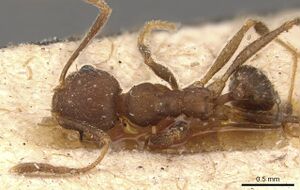 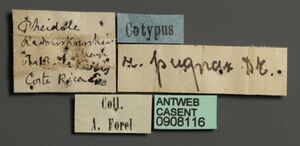
| |
| Syntype of Pheidole pugnax. Worker. Specimen code casent0908116. Photographer Will Ericson, uploaded by California Academy of Sciences. | Owned by MHNG, Geneva, Switzerland. |
Major
Images from AntWeb
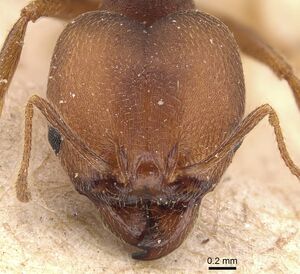   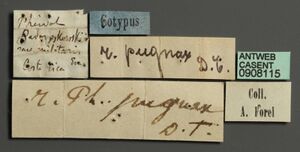
| |
| Syntype of Pheidole pugnax. Worker (major/soldier). Specimen code casent0908115. Photographer Will Ericson, uploaded by California Academy of Sciences. | Owned by MHNG, Geneva, Switzerland. |
Nomenclature
The following information is derived from Barry Bolton's Online Catalogue of the Ants of the World.
- militaris. Pheidole radowszkowskii r. militaris Emery, 1890b: 49 (s.w.) COSTA RICA. [Junior primary homonym of militaris Smith, F. 1860a: 74, above.] Replacement name: pugnax Dalla Torre, 1892: 91.
- pugnax. Pheidole radoszkowskii subsp. pugnax Dalla Torre, 1892: 91. Replacement name for militaris Emery, 1890b: 49. [Junior primary homonym of militaris Smith, F. 1860a: 74.] Raised to species: Wilson, 2003: 219.
Unless otherwise noted the text for the remainder of this section is reported from the publication that includes the original description.
Description
From Wilson (2003): A member of the diligens group very similar to the more widespread Pheidole radoszkowskii, as well as Pheidole diligens, and distinguished as follows.
Major: promesonotal dorsum hairy; space between eye and antennal fossa rugoreticulate; carinulae of frontal lobes extend posteriorly beyond eye level only about a single Eye Length; all of dorsal surface of head except frontal triangle and all of mesosoma and waist foveolate and opaque; three-fourths to all of central strip of first gastral tergite and the posterior central strip of second shagreened; pronotum in dorsal-oblique view subangulate, not bilobous.
Minor: all of head and body foveolate and opaque; all of central strip of first gastral tergite and posterior central strip of second gastral tergite shagreened.
MEASUREMENTS (mm) Syntype major: HW 1.42 HL 1.42, SL 0.84, EL 0.20, PW 0.66. Minor (Quetzaltepeque, El Salvador): HW 0.54, HL 0.60, SL 0.76, EL 0.12, PW 0.34.
COLOR Major and minor: varies among series from dark yellow to medium reddish brown.
Figure. Upper: major. Lower: minor. Scale bars = 1 mm.
Type Material
EL SALVADOR: 2–4 km south of Quetzaltepeque, col. William L. Brown, compared with syntypes. Museo Civico di Storia Naturale, Genoa and National Museum of Natural History - as reported in Wilson (2003)
Etymology
L pugnax, combative. (Wilson 2003)
References
- Wilson, E. O. 2003. Pheidole in the New World: A dominant, hyperdiverse ant genus. Harvard University Press, Cambridge, MA. (page 219, fig. major, minor described; raised to species)
- Camargo-Vanegas, J.J., Guerrero, R.J. 2020. Las hormigas Pheidole (Formicidae: Myrmicinae) en el bosque seco tropical de Santa Marta, Colombia. Revista Colombiana de Entomologia 46(2): e8433 (doi:10.25100/socolen.v46i2.8433).
- Dalla Torre, K. W. von. 1892. Hymenopterologische Notizen. Wien. Entomol. Ztg. 11: 89-93 (page 91, replacement name for militaris)
- Emery, C. 1890c. Studii sulle formiche della fauna neotropica. Bull. Soc. Entomol. Ital. 22: 38-80 (page 49, junior primary homonym of militaris)
- Franco, W., Ladino, N., Delabie, J.H.C., Dejean, A., Orivel, J., Fichaux, M., Groc, S., Leponce, M., Feitosa, R.M. 2019. First checklist of the ants (Hymenoptera: Formicidae) of French Guiana. Zootaxa 4674, 509–543 (doi:10.11646/zootaxa.4674.5.2).
- Houadria, M., Menzel, F. 2021. Digging Deeper into the Ecology of Subterranean Ants: Diversity and Niche Partitioning across Two Continents. Diversity 13, 53 (doi:10.3390/d13020053).
- Smith, F. 1860a. Descriptions of new species of hymenopterous insects collected by Mr. A. R. Wallace at Celebes. J. Proc. Linn. Soc. Lond. Zool. 5(17b)(suppl. to vol. 4 4: 57-93 (page 74, primary homonym)
References based on Global Ant Biodiversity Informatics
- Emery C. 1894. Estudios sobre las hormigas de Costa Rica. Anales del Museo Nacional de Costa Rica 1888-1889: 45-64.
- Fernández, F. and S. Sendoya. 2004. Lista de las hormigas neotropicales. Biota Colombiana Volume 5, Number 1.
- Franco W., N. Ladino, J. H. C. Delabie, A. Dejean, J. Orivel, M. Fichaux, S. Groc, M. Leponce, and R. M. Feitosa. 2019. First checklist of the ants (Hymenoptera: Formicidae) of French Guiana. Zootaxa 4674(5): 509-543.
- Houadria M., A. Salas-Lopez, J. Orivel, N. Bluthgen, and F. Menzel. 2015. Dietary and temporal niche differentiati on in tropical ants—can they explain local ant coexistence? Biotropica 47(2): 208-217.
- Longino J. T. L., and M. G. Branstetter. 2018. The truncated bell: an enigmatic but pervasive elevational diversity pattern in Middle American ants. Ecography 41: 1-12.
- Maes, J.-M. and W.P. MacKay. 1993. Catalogo de las hormigas (Hymenoptera: Formicidae) de Nicaragua. Revista Nicaraguense de Entomologia 23.
- Menozzi C. 1927. Formiche raccolte dal Sig. H. Schmidt nei dintorni di San José di Costa Rica. Entomologische Mitteilungen. Berlin-Dahlem. 16: 266-277.
- Ottonetti L., L. Tucci, F. Frizzi, G. Chelazzi, and G. Santini. 2010. Changes in ground-foraging ant assemblages along a disturbance gradient in a tropical agricultural landscape. Ethology Ecology & Evolution 22: 7386.
- Smith M. A., W. Hallwachs, D. H. Janzen. 2014. Diversity and phylogenetic community structure of ants along a Costa Rican elevational gradient. Ecography 37(8): 720-731.
- Wetterer J. K., M. J. Liles, J. M. Sermeno, L. Serrano Cervantes, E. E. Echeverria, R. M. Estrada Hernandez, A. Henriquez, D. Perez, D. A. Sanchez Garcia, C. E. Gomez Peralta, R. Lopez Sorto, and G. Melendez. 2016. Predaceous fie ants (Hymenoptera: Formicidae) at sea turtle (Testudines: Cheloniidae) nestig beaches and hatcheries in El Salvador. Florida Entomologist 99(1): 106-109.
- Wilson, E.O. 2003. Pheidole in the New World: A Dominant, Hyperdiverse Genus. Harvard University Press
